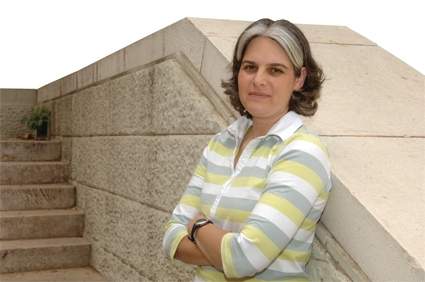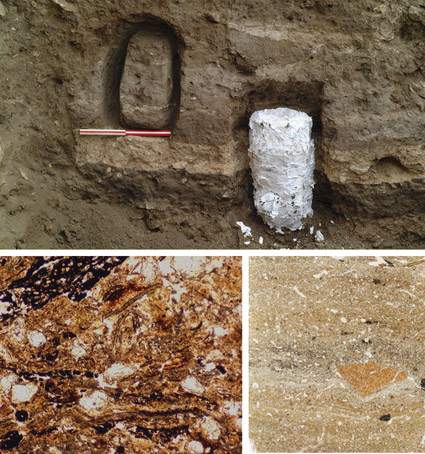Are you a journalist? Please sign up here for our press releases
Subscribe to our monthly newsletter:

The present can supply us with intriguing glimpses into the past. In geology, for example, long-term processes that continue to this day can shed light on those belonging to the distant past. The same principle guides ethno-archaeologists, who study today’s traditional societies to learn about the lifestyles of ancient cultures. Dr. Ruth Shahack-Gross, who began her research career as a geologist, became captivated by this approach when she turned to archaeology: “I was immediately fascinated by the idea of learning about the past from contemporary traditional lifestyles,” she says.
In her studies in Kenya, Shahack-Gross used the geo-ethno-archaeological approach to identify ancient livestock enclosures. Accompanied by a Maasai tribe elder, she collected soil samples from his village and from a series of abandoned villages in which he had lived in the past. In this manner, she managed to create a “time axis” describing the breakdown of organic matter over 40 years. Under the guidance of Prof. Stephen Weiner of the Weizmann Institute’s Helen and Martin Kimmel Center for Archaeological Science, she developed a method for identifying livestock premises using a variety of soil analyses and microscopic tests, including an analysis of phytoliths – tiny silica particles present in many grasses, including animal feed, that end up in cattle dung. An analysis of phytoliths and additional minerals allows her to identify livestock enclosures long after organic matter – a more direct but less stable evidence of their presence – has disintegrated.
Shahack-Gross then joined a Kimmel Center team at the excavations in Tel Dor, where she got an opportunity to apply her method. Together with collaborators from Israel and Spain, she showed that the white-powdered surfaces in the excavated town were collections of phytoliths originating in the dung of livestock kept in enclosures within the city (and not from man-made plaster floors, as had been believed earlier). She also found evidence that animal dung had been used as fuel. These findings suggest that today’s clear-cut divide between agricultural and urban settlements came into being later than previously thought, providing new insights into the nature of the so-called “urban revolution” thought to have occurred in antiquity in the Mediterranean region.
Shahack-Gross, a senior lecturer in the Department of Land of Israel Studies and Archaeology at Bar-Ilan University, joined the Kimmel Center as a visiting scientist as part of a joint program initiated by Weiner. She uses a variety of analytical methods – infrared spectroscopy and oxygen and carbon isotope geochemistry, as well as microscopy – to identify the phytoliths and other materials in soil and ash samples. These methods allow her to gain new information about ancient societies, including the types of food consumed by their cattle. “Today hardly any archaeological excavations are conducted without backing from the natural sciences,” she says.
In another ethno-archaeological study, conducted with Prof. Israel Finkelstein of Tel Aviv University, she used analysis of materials, including phytoliths, to help solve a controversy over settlements created in the Negev Highlands during the Iron Age, corresponding to the Biblical period of Kings (circa 1,200 – 600 BCE). One opinion, based on the Bible, states that certain buildings are remains of fortresses built by King Solomon to protect his kingdom from Egypt and that they were destroyed by Pharaoh Sheshonq I during his northern campaign in the late tenth century BCE. Finkelstein, however, claimed that these buildings had been erected by cattle herders, but he relied on “circumstantial” evidence: The so-called “fortresses” were not located at strategic positions and did not have the uniform appearance of military structures.
Shahack-Gross collected numerous ash and soil samples from two sites near Sde Boker. Her analysis revealed traces of goat dung in the central courtyards of these fortresses. The sediments at the Negev Highlands sites were very low in phytoliths, reflecting a diet of wild plants and lichen. In addition, no phytoliths originating in domestic cereals – in other words, in agricultural crops – were found. These results, backed by analyses of sediments in contemporary Bedouin settlements in the Negev, suggest that the residents of the fortresses were indeed shepherds. And the hypothesis that the Iron Age settlements in the Negev Highlands were built as part of the Kingdom of Judea must be reconsidered.
The dating of plant remains using radioactive carbon, conducted in collaboration with Dr. Elisabetta Boaretto of Bar-Ilan University and the Weizmann Institute’s Kimmel Center, showed that these sites were set up in the late tenth century BCE and operated for about 100 years, until the end of the ninth century BCE. “Sheshonq’s campaign might have led to the creation rather than destruction of these settlements,” Shahack-Gross says. “Moreover, evidence suggests that these were seasonal settlements typical of nomadic herders.” In additional analyses, the scientists will try to determine whether these settlements were indeed seasonal and what they were like during the Iron Age.
Prof. Stephen Weiner’s research is supported by the Kekst Family Center for Medical Genetics; the Helen and Martin Kimmel Center for Archaeological Science; the Maurice and Vivienne Wohl Charitable Foundation; and the estate of George Schwartzman. Prof. Weiner is the incumbent of the Dr. Walter and Dr. Trude Borchardt Professorial Chair in Structural Biology.
